Confronting model predictions of carbon fluxes with measurements of Amazon forests subjected to experimental drought.
Confronting model predictions of carbon fluxes with measurements of Amazon forests subjected to experimental drought.
Author(s): POWELL, T. I.; GALBRAITH, D. R.; CHRISTOFFERSEN, B. O.; HARPER, A.; IMBUZEIRO, H. M. A.; ROWLAND, L.; ALMEIDA, S.; BRANDO, P. M.; COSTA, A. C. L. da; COSTA, M. H.; LEVINE, N. M.; MALHI, Y.; SALESKA, S. R.; SOTTA, E.; WILLIAMS, M.; MEIR, P.; MOORCROFT, P. R.
Summary: Considerable uncertainty surrounds the fate of Amazon rainforests in response to climate change. Here, carbon (C) flux predictions of five terrestrial biosphere models (Community Land Model version 3.5 (CLM3.5), Ecosystem Demography model version 2.1 (ED2), Integrated BIosphere Simulator version 2.6.4 (IBIS), Joint UK Land Environment Simulator version 2.1 (JULES) and Simple Biosphere model version 3 (SiB3)) and a hydrodynamic terrestrial ecosystem model (the Soil?Plant?Atmosphere (SPA) model) were evaluated against measurements from two large-scale Amazon drought experiments. Model predictions agreed with the observed C fluxes in the control plots of both experiments, but poorly replicated the responses to the drought treatments. Most notably, with the exception of ED2, the models predicted negligible reductions in aboveground biomass in response to the drought treatments, which was in contrast to an observed c. 20% reduction at both sites. For ED2, the timing of the decline in aboveground biomass was accurate, but the magnitude was too high for one site and too low for the other. Three key findings indicate critical areas for future research and model development. First, the models predicted declines in autotrophic respiration under prolonged drought in contrast to measured increases at one of the sites. Secondly, models lacking a phenological response to drought introduced bias in the sensitivity of canopy productivity and respiration to drought. Thirdly, the phenomenological water-stress functions used by the terrestrial biosphere models to represent the effects of soil moisture on stomatal conductance yielded unrealistic diurnal and seasonal responses to drought.
Publication year: 2013
Types of publication: Journal article
Unit: Embrapa Amapá
Observation
Some of Embrapa's publications are published as ePub files. To read them, use or download one of the following free software options to your computer or mobile device. Android: Google Play Books; IOS: iBooks; Windows and Linux: Calibre.
Access other publications
Access the Agricultural Research Database (BDPA) to consult Embrapa's full library collection and records.
Visit Embrapa Bookstore to purchase books and other publications sold by Embrapa.

